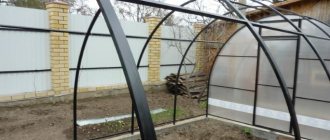- February 21, 2019
- Miscellaneous
- KaplyaDegtya
When during the installation process it becomes necessary to bend the pipe at the required angle, fittings are used - corners specially designed for this. But on difficult turns, several such corners are required, and this does not look aesthetically pleasing. Or maybe it’s just that they are not available at the moment, but installation needs to continue. It is in such cases that the question arises of how to bend a plastic pipe at home.
The manufacturer does not recommend doing this, but you can still bend the pipe. And now we will tell you how.
Types of plastic pipes
Before deciding how to bend a plastic pipe, you need to know that different polymers are used in their manufacture and they all bend completely differently. Plastic pipes are:
- Polyethylene. The most suitable material for creating bends. Even complex curves can be formed from this pliable material. The disadvantage of such pipes is that they are quite fragile and have poor heat resistance. Such a pipe can be bent either cold or hot.
- PVC (polyvinyl chloride). Pipes made of this material are quite fragile, so they can only be bent using a hot method. But that’s not all, since you can only bend a plastic pipe at home if it’s not wide. If you want to change the shape of a pipe with a large diameter, you will need special electromechanical industrial equipment.
- Polypropylene. Pipes made from this material are the strongest, but also the hardest. Polypropylene melts only at very high temperatures, and that is why bending such a pipe at home is quite difficult. A polypropylene pipe can only be given a slight bend using a cold method.
Keep in mind that you can bend a plastic pipe with your own hands, but no matter what material it is made of, it will become thinner on the outside and, on the contrary, thicken on the inside. Carefully check the pipe in the bend area for leaks before installation. Also try to avoid bending the angle too much.
So, how to bend a plastic pipe? There are, as we said above, cold and hot methods. Let's look at them in more detail.
Bending on a molding machine
A polypropylene pipe can be bent with high quality using a special molding machine.
This method allows you to complete the task with minimal effort and achieve great accuracy in the angle and bend radius.
Before starting work, it is necessary to make a frame with the required radius to shape the product. For its manufacture, you can use fiberboard. When creating a frame, you need to carefully sand all surface defects that could damage the plastic (jags, sharp corners, etc.) with sandpaper. After this, a special silicone shell is formed on a molding machine. Its diameter should be slightly larger compared to the diameter of the pipe.
The plastic pipe is placed in a shell secured to a prepared fiberboard frame. The entire structure must be placed on the molding machine. Then the product is heated. In this case, the plastic gradually becomes flexible, and the pipe evenly lies on the frame, taking the desired shape. The product is left to cool for 10 minutes, after which it is removed and removed from the shell. After this, the pipe must be put aside until it cools completely. When it has completely cooled, it can be used to install the pipeline.
Cold way
This method can only bend a metal, metal-plastic or plastic pipe with thin walls and a small diameter.
You will need:
- Purchase a special spring that will match the internal diameter of the pipe.
- When it is not possible to purchase a spring, it can be replaced with sand by pouring it inside the pipe and plugging it on both sides with wooden or plastic plugs.
- Make a template from chipboard or cardboard that will correspond to the bend angle you require.
Further, everything will depend on the diameter of the pipe, since it is possible to bend a plastic pipe of small diameter without the use of special clamps, and for larger diameters or made of harder materials, or having thicker walls, special electromechanical (pipes over 6 cm) or hydraulic ( pipes up to 6 cm) machines.
Bending a square thin-walled pipe
Very often it is necessary to bend thin-walled square pipes, for example, when creating structures that require smooth rotation. Obviously, bending a strong square pipe by hand will not work. That's why a pipe bender is used. Although, you can use another method.
It is necessary to fill the profile thin-walled pipe with sand. Close the ends with plugs and secure the pipe at the ends in a vice, for example. Next, using light taps with a rubber hammer, bend the pipe until the desired radius is achieved. The sand inside the product will prevent the pipe walls from deforming in an unnecessary direction. And in order to bend the pipe even more, you need to do the same, only as an addition, use a blowtorch for heating. Heated metal bends better.
How to bend a plastic sewer pipe using a spring?
- Place the spring inside the pipe. In cases where the internal diameter of the pipe is slightly larger than the diameter of the spring, the latter can be fixed to the pipe with clamps.
- Slowly bend the pipe, gradually achieving the required bend radius. Keep in mind that when bent, polyethylene pipes gradually take on their previous shape, so when bending, they must initially be given a larger radius.
This method is, in principle, universal, since it is also possible to bend a plastic water pipe in this way. In general, the purpose of the pipe does not play any role - when bending, only the type of polymer used in its manufacture is important.
Basic rules for working with plastic
To bend a polypropylene pipe without violating its integrity, you must take into account the rules for working with plastic:
- Bending technology resembles the process of working with metal products. To change the shape of a plastic part, you need to heat it. For this purpose, you cannot use blowtorches or burners. A hair dryer with a temperature control is suitable.
- The workplace must be cleared of any flammable materials and liquids.
- Wear gloves made of fire-resistant material.
- When bending, perform movements smoothly.
- Control the bend radius. The maximum value is the tube diameter multiplied by 8.
We must not forget that plastic is easily deformed from high temperatures. Therefore, when bending pipes, it is necessary to control the temperature. The optimal temperature is 170 degrees.
Hot way
Before bending a plastic pipe using this method, you also need to prepare a special spring (pipe bender). In addition, you will need:
- Construction hair dryer with multi-stage temperature control.
- Forming machine. You can make it yourself from a piece of chipboard by attaching clamps to it in the places of planned bends.
- Make blanks from the block that correspond to the bend angle of the pipe.
We use a hair dryer
However, if you don’t have a hair dryer at hand, you can use a gas burner. In addition, you will need any object made of hard material that has the angle necessary for bending. This will be the template. It is necessary to clarify that the surface of the template must be perfectly flat. This will help avoid dents and cracks on the surface of the pipe.
The further process of bending at home is as follows:
- The product is heated evenly over the entire fold surface. Do not overdo this procedure and do not bring the plastic too close to the fire. This material burns great! Therefore, take precautions!
- When the surface becomes plastic, the pipe is pressed against the template and bent at the desired angle.
- It is recommended to hold the product until the surface has completely hardened.
- When the heated area has hardened, further installation can begin.
Hot bending instructions
You need to do the following:
- Prepare the pipe by inserting a spring into it. You can, just like with the cold method, pour sand inside it, but at high temperatures it can melt into the inner walls of the pipe, which is why the pipe will become rough at the bend. All the debris will linger there and dirt will constantly stick.
- The prepared pipe must be secured to the machine using clamps. You can also use a silicone molding sleeve.
- In the places of the planned bend, place templates of bars on top of the pipe, along which the pipe will be bent.
- Heat the pipe with a hairdryer while simultaneously creating a bend according to the template. The melting point of PVC is 130 degrees, polypropylene is 150. The pipe must be bent very smoothly and slowly, otherwise a sagging or fold will form on the inside of the bend.
- After all the bends are made, the pipe is left on the clamps in this position until it cools completely.
It is also necessary to check the correctness of the bend after the pipe has completely cooled.
Properties of plastic pipeline
All plastic pipes can be divided according to the material they are made of: they are made from polymers, polyethylene, polyvinyl chloride. The listed materials have good hygienic characteristics, so they are excellently used for arranging a heating network, as well as for organizing water supply in an apartment.
It’s not always possible to bend the material yourself, so you have to use popular methods
To bend a plastic pipe yourself, you need to learn more about its properties:
- Ring stiffness. The high rigidity of PVC allows it to withstand atmospheric pressure of 120 atmospheres.
- Heat resistance. Plastic is resistant to heat, so it is used for arranging water supply systems with hot and cold water, as well as for organizing heating pipelines. When heated, plastic only expands by 5%.
- Low resistance to frost. Due to their low resistance to frost, the materials cannot withstand temperatures below -15 degrees, and therefore require additional thermal insulation.
- High light transmittance. The PVC pipe, painted in various colors, is UV resistant.
PVC products for pipeline installation are available in various diameters
When heated, the plastic pipe can be carefully bent because it has good elastic properties. Products made from bendable polyvinyl chloride during production can initially be wound into rings - in this form they go on sale.
How to check the result of your work
- First, you need to visually evaluate the work - inspect the pipe for chips, sagging, cracks, folds and any other defects. A well-bent pipe has no external signs of bending.
- Secondly, before bending the plastic pipe, you made a template along the bend radius. It is necessary to check whether the obtained result matches the desired one.
- Third, pour water inside the pipe and check its tightness. But you should know that even a sealed pipe at the bend will gradually become thinner, especially with high water pressure. Microcracks will appear in it, and such a pipe will have to be replaced.
Safety precautions at work
To avoid harming yourself when working with heating equipment, you must follow the safety rules:
- Work in protective gloves and overalls.
- The room in which work is carried out must have good ventilation.
- Check the heating apparatus for defects.
When buying a construction hair dryer, it is better to choose a model with a temperature controller and a display.
When a person begins installing a pipeline in a private home, he may encounter many obstacles along the way of laying pipes. In order to get around them without destroying them, you need to learn how to bend the tubes at different angles. Anyone can perform bending by choosing the technology.
Which pipe should not be used?
If, after cooling, you see that strong folds have appeared on the inside of the bend or, conversely, that the outside is very thin, then, unfortunately, such a pipe cannot be used. All kinds of dirt will constantly accumulate in the folds, and the pipe will become constantly clogged. And a thinned inner side will lead to rapid wear.
Also, if after the pipe has cooled down you see that you were unable to achieve the desired bend, then you need to either throw it away or use it in a place where this radius is suitable, since it will not be possible to bend the plastic pipe again. That is why it is advised to make preliminary templates and bend the pipe strictly according to them.
Why make a bend?
Many people do not know why to make pipelines of complex shapes. In apartments of multi-storey buildings, a central riser runs through all floors. There is no need to bend the tubes to connect to it. It is enough to select tees, cut into the riser, and divert the water supply circuits from it.
If we are talking about laying a pipeline in a private house and the system is being manufactured from scratch, it is impossible to do without turning the pipes. Tubes are routed from the heating boiler to different rooms. You can avoid making turns and use corner couplings, but this will reduce the reliability of the system. Another area where it is impossible to do without bending pipes is the production of “warm floor” systems.
The ice has broken
The problem has been resolved, what to do next? You will say that you can go relax and enjoy the fruits of victory. But this is the time to think about how to prevent a similar problem from occurring in the future. It is necessary to analyze why the plastic lines froze.
- If the pipe laying depth was chosen correctly, then a leak may have appeared at the joints or the waterproofing may have been damaged. It is important to schedule inspections of all plumbing during the summer.
- If an ice jam occurs between the facade of the building and the ground, then it is necessary to enlarge the hole where the plastic pipes are connected and provide additional thermal insulation from the concrete.
- It may be necessary to equip areas located in open space with electrical heating, with automatic adjustment. So that the system turns on when the set temperatures are reached.
- Or violate all safety standards and regulations and constantly keep at least one of the water taps open. And the first morning flush into the sewer should be done with boiling water.
- If the soil is frozen, then after some time, after the accident is eliminated, the problem will arise again. You need to be prepared for such a scenario.
It is possible to warm up frozen plastic pipes without resorting to the help of specialists with your own hands. The main thing is to prepare in advance for the winter season. Although plastic pipes are flexible and can withstand significant expansion, it is best not to test their strength.
Who is to blame and what needs to be done?
The reasons for freezing of water mains are commonplace. These are errors in the installation of water supply, sudden temperature changes, lack of fluid movement, and the presence of a leak. For sewerage, the cause may be blockages and overflow of drains.
At the stage of building a house, preventive work is important:
- Determining the maximum depth of soil freezing. Accordingly, the laying of the pipeline is below this point.
- If it is impossible to fulfill the first condition, it is necessary to insulate the line with heat-insulating materials, for example polyester, on one side of which there is a layer of heat-reflecting foil.
Pipe insulation
Pipe heating
- Ensuring a constant flow of water. In severe frosts, it is necessary to open the taps at night. If the system is not used for a long time, it is necessary to completely remove water from it.
- When installing a water supply system, it is necessary to wrap the lines with an electric heating cable.
Particular attention should be paid to the places where the pipe comes out of the ground and enters the structure.











